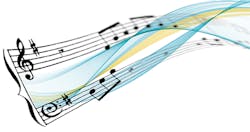I LISTENED IN amazement recently as Gustavo Dudamel conducted the LA Philharmonic in a violin concerto. As the interplay of perfectly executed notes and pleasant harmonies filled my senses, I wondered about the role a conductor plays as leader of an orchestra. Each of the musicians has the score, indicating precisely which string to pluck and note to play. But I was curious: if you took the conductor away, could the orchestra play as beautifully on its own?
Apparently, I’m not the only one who wonders such things. As NPR reported, Yiannis Aloimonos, of the University of Maryland, and colleagues performed an experiment in 2012 with a group of musicians from Ferrara, Italy.
The researchers installed a tiny infrared light on the tip of the conductor's baton and placed similar lights on the bows of the violinists in the orchestra. Infrared cameras captured the movement of lights when the conductor waved the baton and the violinists moved their bows. Computers analyzed the infrared patterns to determine whether the movements of the conductor were linked to those of the violinists.
The study found that conductors were, in fact, leading the violinists’ movements. But the researchers also asked two conductors to lead the same orchestra. One exercised strong control over the violinists, while the other used a lighter touch. Without knowledge of who was leading, music experts listened to the performances and found the version produced by the more exigent conductor more pleasing. It seems that centralized control created a more precise and harmonious sound.
The same may be said of the way we manage and control the flow of water today. In this issue of Water Efficiency, we explore the myriad ways in which organizations are managing the function of diverse assets and data streams from a multitude of sensors. In the following pages, we’ve highlighted essential components—pumps, pipes, meters, and leak detection technologies—in an effort to demonstrate that precise orchestration of key pieces of the puzzle can contribute to a more harmonious and efficient system.
In “Accuracy and Integration,” we explore the many advantages offered by smart meters. Today’s AMI networks can link meters, assets, and control devices for optimized system efficiency. Furthermore, precision data collection is able to pinpoint water leaks while open architecture software solutions are making it easier to integrate data sources and accommodate an impressive amount of sensor data.
An estimated 240,000 water main breaks occur in the US each year, wasting 2 trillion gallons of water. In “The Price of Pipes,” we look at a variety of methods and materials for repairing pipelines and reinforcing water systems. From high-tech gaskets, repair clamps, and dynamic couplings to glass fiber reinforced polymer mortar pipe and contemporary polyethylene encasements, we observe that the current generation of advanced pipe repair technologies can have an optimizing effect on system efficiency.
In “The Evolution of Listening,” we highlight innovations in leak detection. From lift-and-shift applications of acoustic correlation using radio loggers to correlating technology that leverages cellular and cloud-based technologies and leak sensing robots that travel through a pipeline detecting pressure differences, the advancements taking place in leak detection are catalyzing water efficiency in systems across the globe.
Coordinated technologies, synchronized assets, and merged data streams make it evident that intelligent organization—a well-led orchestra—can help optimize and integrate individual assets with diverse functionalities to make our water systems more effective, resilient, and symphonic.
